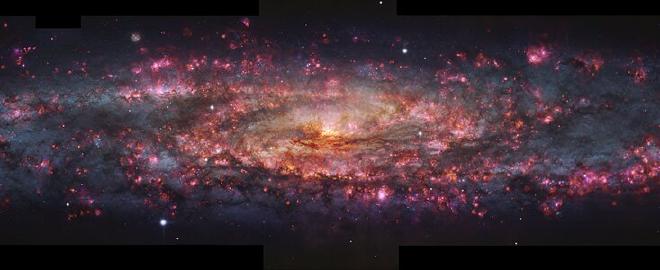

“Galaxies are incredibly complex systems that we are still struggling to understand,” says ESO researcher Enrico Congiu, who led a new Astronomy & Astrophysics study on Sculptor. Reaching hundreds of thousands of light-years across, galaxies are extremely large, but their evolution depends on what’s happening at much smaller scales. “The Sculptor Galaxy is in a sweet spot,” says Congiu. “It is close enough that we can resolve its internal structure and study its building blocks with incredible detail, but at the same time, big enough that we can still see it as a whole system.”

A galaxy’s building blocks — stars, gas and dust — emit light at different colours. Therefore, the more shades of colour there are in an image of a galaxy, the more we can learn about its inner workings. While conventional images contain only a handful of colours, this new Sculptor map comprises thousands. This tells astronomers everything they need to know about the stars, gas and dust within, such as their age, composition, and motion.
The Sculptor Galaxy is the subject of a highly detailed portrait, an image that astronomers made containing thousands of colours. To capture the galaxy in this light, the team of researchers observed it for over 50 hours with the Multi Unit Spectroscopic Explorer (MUSE) instrument on ESO’s Very Large Telescope (VLT). Credit: ESO/L. Calçada/N. Risinger (skysurvey.org)/Digitized Sky Survey 2/E. Congiu et al. Music: Azul Cobalto.
This zoom was created with images from different telescopes stitched together, covering progressively smaller areas in the sky, ending on the final portrait in all its glory.
To create this map of the Sculptor Galaxy, which is 11 million light-years away and is also known as NGC 253, the researchers observed it for over 50 hours with the Multi Unit Spectroscopic Explorer (MUSE) instrument on ESO’s VLT. The team had to stitch together over 100 exposures to cover an area of the galaxy about 65 000 light-years wide.
According to co-author Kathryn Kreckel from Heidelberg University, Germany, this makes the map a potent tool: “We can zoom in to study individual regions where stars form at nearly the scale of individual stars, but we can also zoom out to study the galaxy as a whole.”
In their first analysis of the data, the team uncovered around 500 planetary nebulae, regions of gas and dust cast off from dying Sun-like stars, in the Sculptor Galaxy. Co-author Fabian Scheuermann, a doctoral student at Heidelberg University, puts this number into context: “Beyond our galactic neighbourhood, we usually deal with fewer than 100 detections per galaxy.”
Because of the properties of planetary nebulae, they can be used as distance markers to their host galaxies. “Finding the planetary nebulae allows us to verify the distance to the galaxy — a critical piece of information on which the rest of the studies of the galaxy depend,” says Adam Leroy, a professor at The Ohio State University, USA, and study co-author.
Future projects using the map will explore how gas flows, changes its composition, and forms stars all across this galaxy. “How such small processes can have such a big impact on a galaxy whose entire size is thousands of times bigger is still a mystery,” says Congiu.
The Team #
The team is composed of E. Congiu (European Southern Observatory, Chile [ESO Chile]), F. Scheuermann (Astronomisches Rechen-Institut, Zentrum für Astronomie der Universität Heidelberg, Germany [ARI-ZAH]), K. Kreckel (ARI-ZAH), A. Leroy (Department of Astronomy and Center for Cosmology and Astroparticle Physics, The Ohio State University [OSU], USA), E. Emsellem (European Southern Observatory, Germany [ESO Garching] and Univ. Lyon, Univ. Lyon, ENS de Lyon, CNRS, Centre de Recherche Astrophysique de Lyon, France), F. Belfiore (INAF – Osservatorio Astrofisico di Arcetri, Italy), J. Hartke (Finnish Centre for Astronomy with ESO [FINCA] and Tuorla Observatory, Department of Physics and Astronomy [Tuorla], University of Turku, Finland), G. Anand (Space Telescope Science Institute, USA), O. V. Egorov (ARI-ZAH), B. Groves (International Centre for Radio Astronomy Research, University of Western Australia, Australia), T. Kravtsov (Tuorla and FINCA), D. Thilker (Department of Physics and Astronomy, The Johns Hopkins University, USA), C. Tovo (Dipartimento di Fisica e Astronomia ‘G. Galilei’, Universit‘a di Padova, Italy), F. Bigiel (Argelander-Institut für Astronomie, Universität Bonn, Germany), G. A. Blanc (Observatories of the Carnegie Institution for Science, USA, and Departamento de Astronomía, Universidad de Chile, Chile), A. D. Bolatto and S. A. Cronin (Department of Astronomy, University of Maryland, USA), D. A. Dale (Department of Physics and Astronomy, University of Wyoming, USA), R. McClain (OSU), J. E. Méndez-Delgado (Instituto de Astronomía, Universidad Nacional Autónoma de México, Mexico), E. K. Oakes (Department of Physics, University of Connecticut, USA), R. S. Klessen (Universität Heidelberg, Zentrum für Astronomie, Institut für Theoretische Astrophysik and Interdisziplinäres Zentrum für Wissenschaftliches Rechnen, Germany, Center for Astrophysics Harvard & Smithsonian, USA, and Elizabeth S. and Richard M. Cashin Fellow at the Radcliffe Institute for Advanced Studies at Harvard University, USA) E. Schinnerer (Max-Planck-Institut für Astronomie, Germany), T. G. Williams (Sub-department of Astrophysics, Department of Physics, University of Oxford, UK).
- The article Astronomers capture most detailed thousand-colour image of a galaxy was published in ESO’s website.

